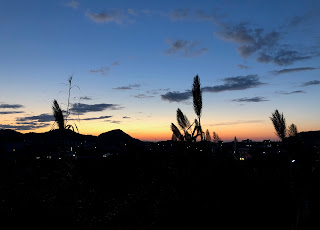-- Susan, every other Sunday
Two years ago next month, I hiked the sacred Kumano Kodo pilgrimage for the second time. This ancient trail is one of two pilgrimages registered as UNESCO World Heritage sites (the other is Spain's Camino de Santiago).
The day before the hike, I traveled south from Tokyo to Yuasa, a tiny town on the western coast of the Kii Peninsula that sits at the juncture where the coastal Kumano Kodo Kii-ji intersects with the Nakahechi--the "central route" that serves as the primary pilgrim trail.
If you've never heard of Yuasa, you're in good company. Even within Japan, it's not particularly well-known.
However, I'm willing to bet you've heard of the reason Yuasa is famous. In fact, you probably have personal experience with Yuasa's primary culinary claim to fame . . . but more on that in a minute.
 |
| Like many Japanese towns, the manhole covers celebrate Yuasa's claim(s) to fame. |
Due in part to its somewhat remote location, Yuasa remains a sleepy coastal fishing town. It sits about 2.5 hours south of Kyoto by a combination of express and local trains.
 |
| Heron fishing in the canal |
Upon arrival, I checked in at my lodgings for the night: Miyoshi-so, a ryokan (traditional inn) that has been serving travelers on the Kumano Kodo pilgrim trail for over 100 years.
 |
| The entrance to Miyoshi-so |
 |
| Welcome tea and a local monaka (crispy filled wafer)-style cookie |
 |
| My guest room. |
After relaxing for a few minutes, I headed out to explore the town. I was scheduled to begin the seven-day trek along the Kumano Kodo Nakahechi the following morning, and wanted to see as much of Yuasa's history as I could that afternoon.
 |
| Preserved homes in Yuasa's historical district |
At the northwest end of the historical district, a building that once served as a shoyu brewery is now home to the Kadocho Soy Sauce Museum--a veritable wonderland for those of us who like small, odd collections of historical artifacts, and also an informative display about Yuasa's claim to fame.
 |
| The entrance to the soy sauce museum |
 |
| Old soy sauce ads, bottles, and artifacts. |
 |
| The implements used to brew traditional shoyu (soy sauce) |
The displays were labeled (in Japanese) with brief explanations of each artifact's role in the shoyu brewing process. They were roughly "in order" from a brewing perspective, though as you can see in the photo above, the museum vibe leaned slightly farther toward "wacky grandpa's shoyu barn" than "true museum."
Unfortunately, this little fishing town doesn't see much tourism--particularly mid-pandemic--and the only restaurant I found open in the historical district was a "fresh catch" place that had only fish on the menu.
 |
| More of Yuasa's preserved buildings |
I started back toward the ryokan, hopes sinking ever lower as I realized even Google Maps had no idea where I could find a restaurant--or even a convenience store--that was open that day in this little town.
Just when I was ready to surrender all hope and wait for dinner (which fortunately was being prepared for me at the ryokan that night), I turned a corner and saw a white tiled building with a sign reading "Coffee Restaurant DONKEY"--and a flag out front that suggested it was open.
 |
| Coffee Restaurant ドンキ-- ("Donkey") |
 |
| A special doria indeed |
The meat sauce smelled homemade--and slightly sweet, which gave me a moment's pause, but I was so hungry I didn't pause for long. As it turned out, the sauce atop the rice was indeed homemade, and fell somewhere between marinara and barbecue sauce (it tasted like a combination of the two) with liberal chunks of minced tomato, carrot, and onion throughout. Stranger still, the rice was mixed with little pieces of . . . scrambled eggs, a little like what you'd expect to see in fried rice, although this rice was steamed and baked in a bechamel sauce (as usual for doria) not fried.)
Now, based on that description, I think we can all agree the dish shouldn't work. Objectively, it sounds just . . . wrong.
But in reality, it was absolutely delicious--the best doria I've ever eaten, bar none, and I eat them often. Long before I finished, I was already regretting the fact that it would probably be two years (at least) before I was able to eat the dish again (since I try to hike the Kumano Kodo in even-numbered years).
It has been a year and eleven months since that fateful lunch, and I still miss that special doria.
Fortunately, it is an even-numbered year, and I do have plans to hike the Kumano Kodo this November. In about eight weeks, if everything goes as planned, I'll head south to Yuasa, to spend another night at Miyoshi-so before setting off on another pilgrimage along the Kumano Kodo Nakahechi.
And you can bet I'll be visiting Donkey the day before.
For now, I'll leave you with a view of sunset in Yuasa, shot from the window of my room at Miyoshi-so...

















Looking forward to travelling with you!
ReplyDeleteOn my must visit list: the home of soy sauce!
ReplyDeleteOh dear, now you have me dreaming of sweet doria!
ReplyDelete